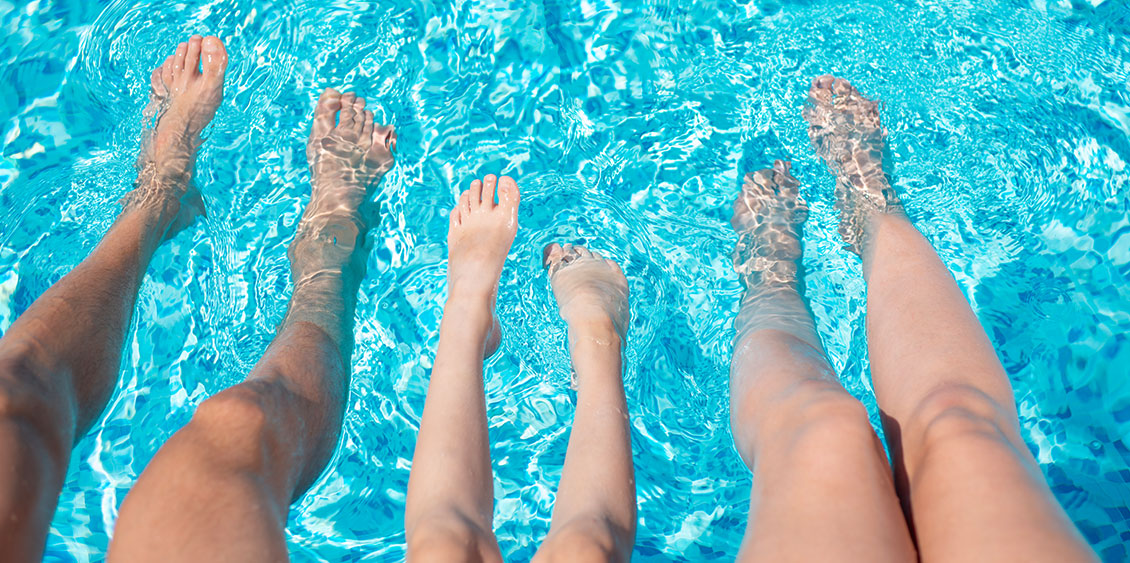Athlete’s foot is a common fungal infection that affects the skin on the feet, especially between the toes. It thrives in warm, damp conditions. This guide will show you how to spot it, treat it fast, and, most importantly, stop it from coming back.

What are the symptoms of athlete’s foot?
Do your feet feel itchy after a day in closed-toed shoes? Is the skin between your toes red, irritated, or peeling? These common early signs could be the first warning signs of athlete’s foot.
The infection usually begins with:
- persistent itching, especially between the toes;
- a red area that may spread, sometimes with small painful cracks;
- peeling skin in the infected spot;
- in some cases, a stronger-than-usual odour.
The infection usually starts between the fourth and fifth toes. If not treated, it can spread to the sole, heel, or sides of the foot. In more serious cases, blisters or thickened skin can appear.
Good to know: It isn’t always easy to tell the difference between simple irritation and a fungal infection. If symptoms persist or get worse, it’s a good idea to talk to your pharmacist right away.
What are the signs of a fungal infection?
A fungal infection often stands out by how persistent it is: It doesn’t go away with basic care and tends to come back in the same spot. If the problem spreads, changes in appearance, or persists between the toes in a damp, whitish area, that’s a clear sign of fungal infection.
What’s the difference between a fungus and a fungal infection?
A fungus is the microorganism itself. A fungal infection is what happens when that fungus grows on the skin, nails, or mucous membranes. In other words: The fungus is the cause and the infection is the result. Athlete’s foot is a fungal infection caused by a fungus that thrives in warm, damp places, like the area between your toes.
How to prevent athlete’s foot
Like many infections, athlete’s foot is easier to prevent than to treat. It starts with a good hygiene routine.
Each day, take a few minutes to do the following:
- Wash your feet with a mild soap, paying extra attention between the toes.
- Dry your feet thoroughly, especially in the creases, to get rid of any moisture.
- Change your socks every day, or more often if your feet sweat a lot.
- Let your shoes air out, and rotate pairs as much as possible so they can dry properly.
Remember: It’s important to wear sandals in pools, spas, and changing rooms. These places are perfect breeding grounds for fungi. Also, follow our tips for healthy, great-looking feet every day.
Products to keep on hand to help prevent fungal infection
At your Brunet pharmacy, you’ll find a range of practical solutions, including:
- antifungal powders for shoes;
- disinfectant sprays for feet and socks;
- preventive creams to add to your morning routine.
These products help lower the risk of developing athlete’s foot, especially if you’re often in environments where it can spread. For help choosing the right products, speak with your pharmacist.
What is the most effective treatment for athlete’s foot?
Athlete’s foot is easy to treat; but it’s important not to ignore it. It’s best to start using an over-the-counter antifungal treatment at the first signs. Creams, powders, gels, and sprays are available in different easy-to-use formats for daily application.
It’s important to finish the entire course of treatment, even if symptoms disappear quickly. Generally, it’s recommended to continue treatment for two to four weeks, following the product’s instructions. If the infection isn’t fully treated, the fungus can return, sometimes stronger and harder to eliminate.
Follow a good daily routine:
- In the morning, apply antifungal cream after washing and drying your feet.
- In the evening, check your skin and change your socks if needed.
- Regularly disinfect your shoes to prevent reinfection.
Remember to always wash your hands after each application to avoid spreading the fungus to other parts of your body or to those around you.
Athlete’s foot: are athletes the only ones at risk?
The name is misleading: Athlete’s foot doesn’t only affect athletes. Anyone who spends long hours in closed-toed shoes or frequents damp environments is at risk. It’s also a common infection among teenagers and people with physically demanding jobs, like construction workers.
Is athlete’s foot contagious?
Yes, athlete’s foot is very contagious. The fungus spreads easily through direct contact with an infected surface. Going barefoot on a shower floor, using a shared towel, or borrowing shoes—all of these can increase the risk of picking up the infection.
Can you get rid of athlete’s foot naturally?
You may have heard that you can treat athlete’s foot with white vinegar foot soaks or antifungal essential oils such as tea tree oil. These home remedies can offer some relief, especially in the early stages of the infection. But on their own, they’re often not enough to fully eliminate it.
Keep in mind that home remedies are not a substitute for medical treatment. Talk to your pharmacist before combining them with an antifungal treatment.
Why is foot care good for your health?
We often forget that looking after our feet is an important part of staying healthy. Keeping them clean and in good condition helps prevent infections, irritation, and everyday discomfort. Hydrated, supple skin reduces the risk of cracks and calluses, and properly trimmed nails can help you avoid ingrown toenails.
Healthy feet contribute to:
- better posture;
- improved balance;
- fewer infections;
- less pain in the back or legs.
You can find all our tips for healthy feet in our article: Don’t forget your feet!
Athlete’s foot: when should you see your doctor?
Athlete’s foot is a common, mild infection that can affect anyone. In most cases, an over-the-counter antifungal treatment from your pharmacy is enough to solve the problem. But sometimes, the infection can persist or worsen.
If you notice no improvement, it’s a good idea to consult a health care professional. To learn more, check out our foot care services.
See a doctor if:
- Your symptoms don’t improve after two weeks of treatment
- The infection spreads to other parts of your body
- You develop open sores or significant pain
- You have diabetes or circulation problems
Last updated on June 26, 2025
Other articles that might interest you

